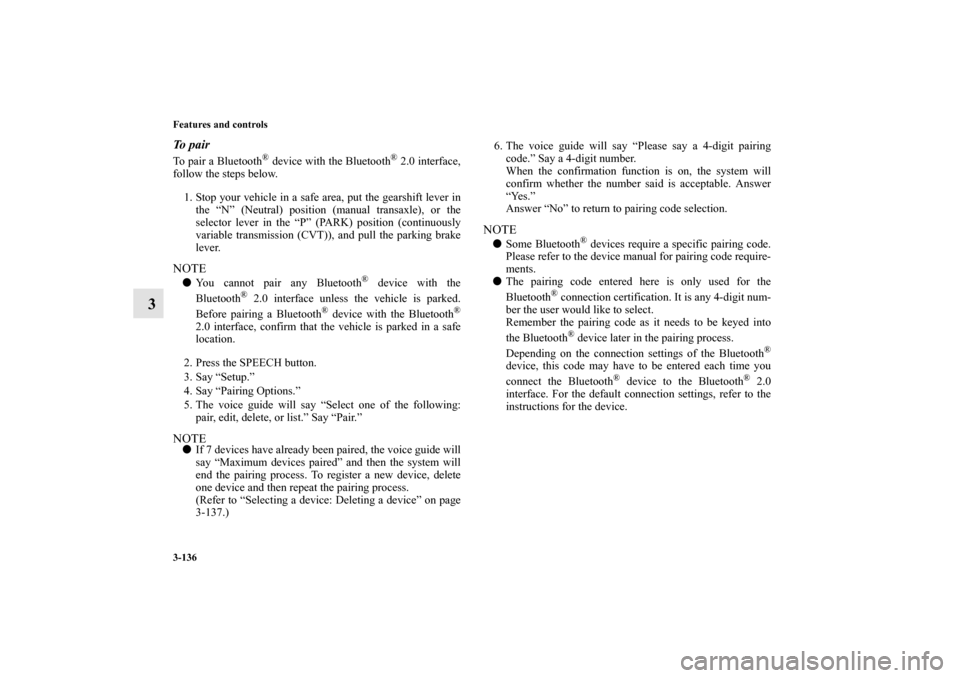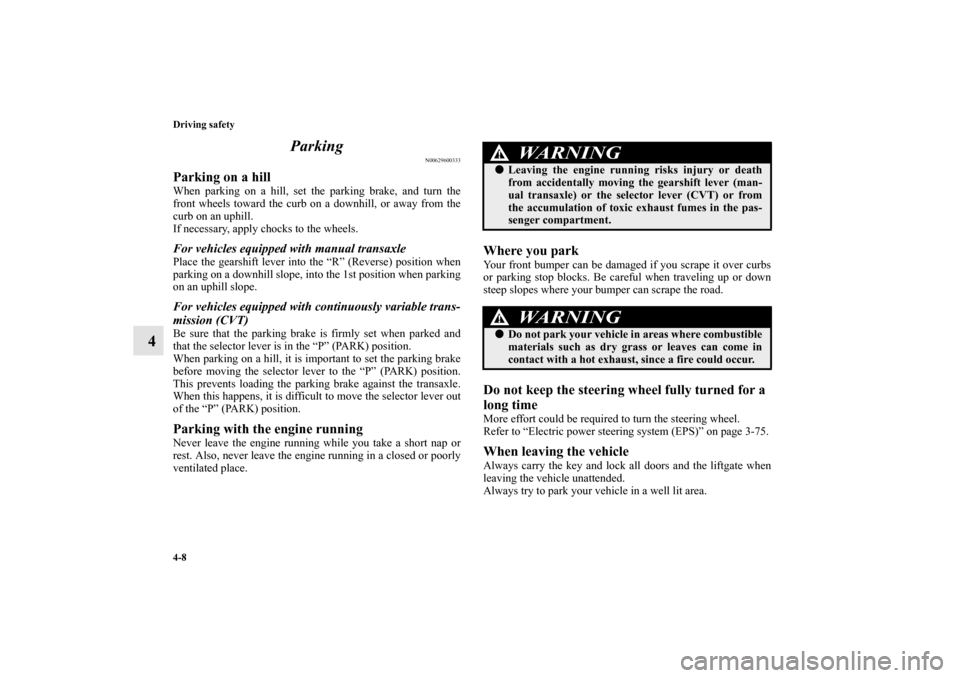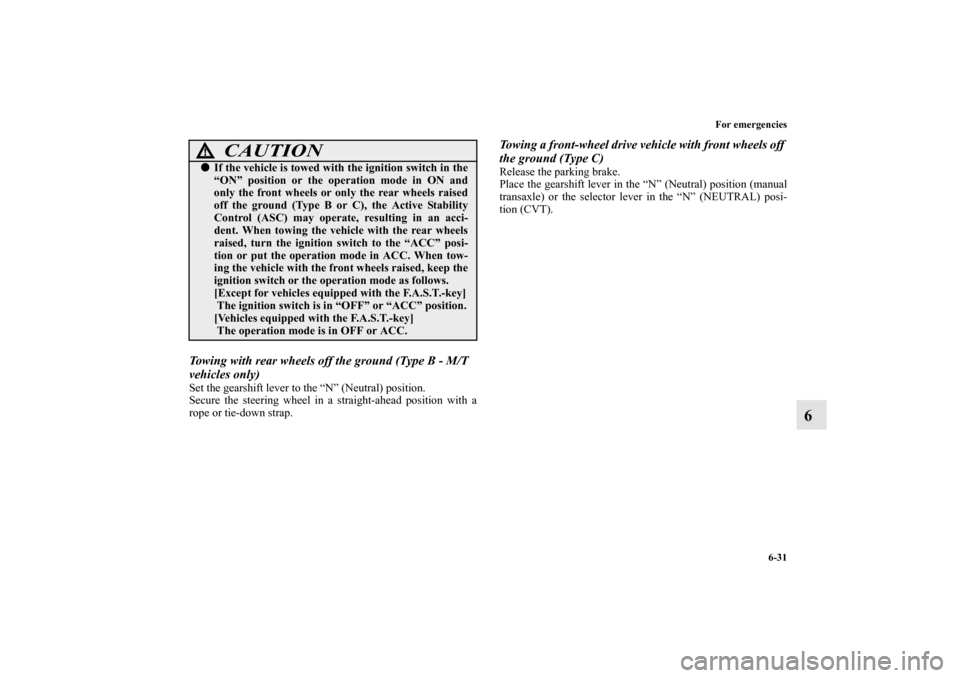Page 224 of 460

3-136 Features and controls
3
To pairTo pair a Bluetooth
® device with the Bluetooth
® 2.0 interface,
follow the steps below.
1. Stop your vehicle in a safe area, put the gearshift lever in
the “N” (Neutral) position (manual transaxle), or the
selector lever in the “P” (PARK) position (continuously
variable transmission (CVT)), and pull the parking brake
lever.
NOTE�You cannot pair any Bluetooth
® device with the
Bluetooth
® 2.0 interface unless the vehicle is parked.
Before pairing a Bluetooth
® device with the Bluetooth
®
2.0 interface, confirm that the vehicle is parked in a safe
location.
2. Press the SPEECH button.
3. Say “Setup.”
4. Say “Pairing Options.”
5. The voice guide will say “Select one of the following:
pair, edit, delete, or list.” Say “Pair.”
NOTE�If 7 devices have already been paired, the voice guide will
say “Maximum devices paired” and then the system will
end the pairing process. To register a new device, delete
one device and then repeat the pairing process.
(Refer to “Selecting a device: Deleting a device” on page
3-137.)6. The voice guide will say “Please say a 4-digit pairing
code.” Say a 4-digit number.
When the confirmation function is on, the system will
confirm whether the number said is acceptable. Answer
“Yes.”
Answer “No” to return to pairing code selection.
NOTE�Some Bluetooth
® devices require a specific pairing code.
Please refer to the device manual for pairing code require-
ments.
�The pairing code entered here is only used for the
Bluetooth
® connection certification. It is any 4-digit num-
ber the user would like to select.
Remember the pairing code as it needs to be keyed into
the Bluetooth® device later in the pairing process.
Depending on the connection settings of the Bluetooth
®
device, this code may have to be entered each time you
connect the Bluetooth
® device to the Bluetooth
® 2.0
interface. For the default connection settings, refer to the
instructions for the device.
BK0162600US.book 136 ページ 2013年3月22日 金曜日 午後2時41分
Page 266 of 460

4-8 Driving safety
4Parking
N00629600333
Parking on a hillWhen parking on a hill, set the parking brake, and turn the
front wheels toward the curb on a downhill, or away from the
curb on an uphill.
If necessary, apply chocks to the wheels.For vehicles equipped with manual transaxlePlace the gearshift lever into the “R” (Reverse) position when
parking on a downhill slope, into the 1st position when parking
on an uphill slope.For vehicles equipped with continuously variable trans-
mission (CVT)Be sure that the parking brake is firmly set when parked and
that the selector lever is in the “P” (PARK) position.
When parking on a hill, it is important to set the parking brake
before moving the selector lever to the “P” (PARK) position.
This prevents loading the parking brake against the transaxle.
When this happens, it is difficult to move the selector lever out
of the “P” (PARK) position.Parking with the engine runningNever leave the engine running while you take a short nap or
rest. Also, never leave the engine running in a closed or poorly
ventilated place.
Where you parkYour front bumper can be damaged if you scrape it over curbs
or parking stop blocks. Be careful when traveling up or down
steep slopes where your bumper can scrape the road.Do not keep the steering wheel fully turned for a
long timeMore effort could be required to turn the steering wheel.
Refer to “Electric power steering system (EPS)” on page 3-75.When leaving the vehicleAlways carry the key and lock all doors and the liftgate when
leaving the vehicle unattended.
Always try to park your vehicle in a well lit area.
WA R N I N G
!�Leaving the engine running risks injury or death
from accidentally moving the gearshift lever (man-
ual transaxle) or the selector lever (CVT) or from
the accumulation of toxic exhaust fumes in the pas-
senger compartment.
WA R N I N G
!�Do not park your vehicle in areas where combustible
materials such as dry grass or leaves can come in
contact with a hot exhaust, since a fire could occur.
BK0162600US.book 8 ページ 2013年3月22日 金曜日 午後2時41分
Page 351 of 460

For emergencies
6-11
6
NOTE�Do not pull out an object, such as a nail or screw, that pen-
etrates the punctured tire.
�Move the vehicle so that the tire valve is positioned away
from the point where the tire touches the ground. If the
valve is near the point where the tire touches the ground,
the sealant may not enter the tire easily.
1. Park the vehicle on a safe, flat and level place.
2. Set the parking brake firmly.
3. On vehicles equipped with manual transaxle, stop the
engine and move the gearshift lever to the “R” (Reverse)
position.
On vehicles equipped with continuously variable trans-
mission (CVT), move the selector lever to the “P”
(PARK) position, and stop the engine.
4. Turn on the hazard warning flashers and set up a warning
sign, such as a warning triangle or flashing signal lamp, at
an adequate distance from the vehicle, and have all your
passengers leave the vehicle.
5. Take out the tire repair kit.
Make sure that the compressor switch is OFF.6. Shake the tire sealant bottle well.
NOTE�In cold conditions (when the ambient temperature is 32 °F
{0 °C} or lower), thickening of the tire sealant can make
the tire sealant hard to squeeze out of the bottle. Warm the
bottle between your hands inside the vehicle.
CAUTION
!�If the vehicle body is contaminated by the tire seal-
ant, wipe the tire sealant off immediately with a wet
cloth.�Immediately wash clothes contaminated with tire
sealant. The tire sealant may not be removed from
the clothes.
BK0162600US.book 11 ページ 2013年3月22日 金曜日 午後2時41分
Page 358 of 460

6-18 For emergencies
6How to change a tire (Vehicles equipped
with spare tire)
N00836900819
Before changing a tire, first stop your vehicle in a safe, flat
location.
1. Park the vehicle on level and stable ground.
2. Set the parking brake firmly.
3. On vehicles equipped with manual transaxle, stop the
engine and move the gearshift lever to the “R” (Reverse)
position.
On vehicles equipped with continuously variable trans-
mission (CVT), move the selector lever to the “P”
(PARK) position, and stop the engine.
4. Turn on the hazard flashers and set up a warning triangle,
flashing signal light, etc., at an adequate distance from the
vehicle, and have all your passengers exit the vehicle.5. To prevent the vehicle from rolling when it is raised on the
jack, place chocks or blocks (A) at the tire that is diago-
nally opposite from the tire (B) you are changing.
WA R N I N G
!�The jack should not be used for any purpose other
than to change a tire.�Never get under the vehicle or put any portion of
your body under the vehicle while it is supported by
the jack.
BK0162600US.book 18 ページ 2013年3月22日 金曜日 午後2時41分
Page 371 of 460

For emergencies
6-31
6
Towing with rear wheels off the ground (Type B - M/T
vehicles only)Set the gearshift lever to the “N” (Neutral) position.
Secure the steering wheel in a straight-ahead position with a
rope or tie-down strap.
Towing a front-wheel drive vehicle with front wheels off
the ground (Type C)Release the parking brake.
Place the gearshift lever in the “N” (Neutral) position (manual
transaxle) or the selector lever in the “N” (NEUTRAL) posi-
tion (CVT).
�If the vehicle is towed with the ignition switch in the
“ON” position or the operation mode in ON and
only the front wheels or only the rear wheels raised
off the ground (Type B or C), the Active Stability
Control (ASC) may operate, resulting in an acci-
dent. When towing the vehicle with the rear wheels
raised, turn the ignition switch to the “ACC” posi-
tion or put the operation mode in ACC. When tow-
ing the vehicle with the front wheels raised, keep the
ignition switch or the operation mode as follows.
[Except for vehicles equipped with the F.A.S.T.-key]
The ignition switch is in “OFF” or “ACC” position.
[Vehicles equipped with the F.A.S.T.-key]
The operation mode is in OFF or ACC.
CAUTION
!
BK0162600US.book 31 ページ 2013年3月22日 金曜日 午後2時41分